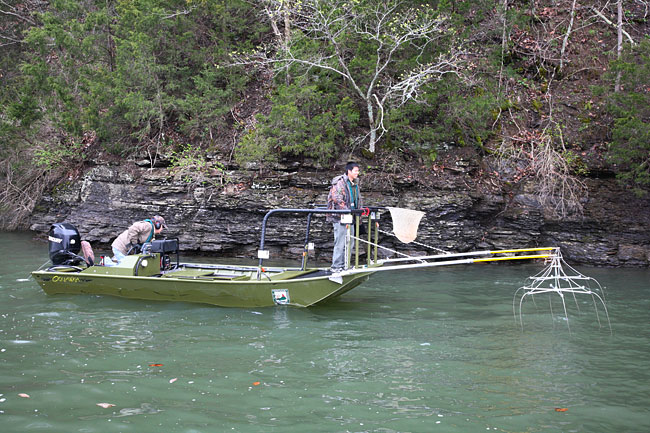Author: Lee McClellan
April 7, 2011 Contact: Lee McClellan
1-800-858-1549, ext. 4443
FRANKFORT, Ky. – The phone calls started in the late afternoon along with posts on fishing related web sites. Some anglers recently witnessed the Fisheries Division of the Kentucky Department of Fish and Wildlife Resources collect smallmouth bass broodstock from Dale Hollow Lake and grew concerned something funny just occurred.

Nothing unusual was afoot. It was part of the fishery management process that occurs every spring in rivers and reservoirs across Kentucky.
“Without broodstock, we cannot stock fish,” said Ron Brooks, director of fisheries for the Kentucky Department of Fish and Wildlife Resources. “We obtain broodstock from public waters. We also don’t keep a lot of broodstock on hand at the hatchery because of feeding costs. We only take broodfish from waters that can handle it and we try and return all of them.”
Fisheries staff at Minor Clark Fish Hatchery in Morehead will spawn the smallmouth bass taken from Dale Hollow Lake and stock the offspring in Paintsville Lake. Smallmouth bass broodstock borrowed from Dale Hollow Lake produced the fish stocked in Laurel River Lake in the mid 1980s. Laurel River Lake is now one of the better trophy smallmouth bass lakes in the upper South and it produced a former 8.46-pound Kentucky state record.
“The Dale Hollow strain reproduces well in reservoirs,” said Gerry Buynak, assistant director of fisheries for Kentucky Fish and Wildlife. “Plus, Dale Hollow smallmouth bass broodstock are proven to work and have the best genetics.”
The waters of Dale Hollow Lake birthed the three biggest smallmouth bass ever recorded: the 11-pound, 15-ounce Kentucky state and all tackle world record taken by David Hayes in 1955, a 10.875 pounder caught in 1969 and a 10.5 pounder taken in 1986. The lake produced six of the top 10 entries on ESPNs Top 25 smallmouth bass of all time.
Fisheries personnel will stock between 20,000 and 30,000 2-inch smallmouth bass in Paintsville Lake in 2011, 2012 and 2013. Any extra hatchery production goes back into Dale Hollow Lake.
“We will return the broodfish in three years. We are holding them for three years because we don’t want to go back every spring and shock people’s fishing holes,” Brooks said. “The broodfish will be well fed and will go back into the lake in better shape than we got them.”
Kentuckians would not enjoy the quality muskellunge fishing found in Cave Run Lake, Buckhorn Lake, Green River Lake or our native muskellunge streams without the broodstock gathering process.
“We go to the Licking River every spring and get fresh muskellunge broodstock for the hatchery,” Buynak said. “Without stocking, the muskellunge fishery in Kentucky would be very limited and unsustainable.”
Kentucky Fish and Wildlife obtains sauger from the Cumberland River below Wolf Creek Dam and Kentucky River, native walleye from Rockcastle River and Lake Erie strain walleye from several reservoirs for hatchery broodstock.
“Spring is the best time to collect broodfish,” Buynak explained. “We replenish our broodstock at the hatchery, spawn them and release the bigger ones back into where we got them and keep some of the small to medium-sized ones at the hatchery in case we need them.”
Buying eggs produced from outside Kentucky for rearing in our hatcheries isn’t practical, except for the trout.
“Every state gets their broodstock from somewhere,” Buynak said. “If the process is working, why buy them from someone? We also want to spawn native fish from our waters to keep our native genetics going when we stock.”
If you see a noisy, odd-looking boat with steel tentacles hanging in the water in front of it and a fish stocking truck at the ramp, you are not witnessing funny business. Kentucky Fish and Wildlife fisheries personnel are in the process of making better fishing in the future for all Kentuckians to enjoy.
-30-
The Kentucky Department of Fish and Wildlife Resources manages, regulates, enforces and promotes responsible use of all fish and wildlife species, their habitats, public wildlife areas and waterways for the benefit of those resources and for public enjoyment. Kentucky Fish and Wildlife is an agency of the Tourism, Arts and Heritage Cabinet. For more information on the department, visit our website at fw.ky.gov.



Be the first to comment